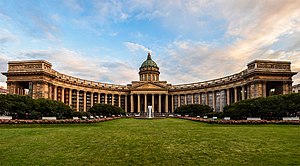Episemialist Church
This article is incomplete because it is pending further input from participants, or it is a work-in-progress by one author. Please comment on this article's talk page to share your input, comments and questions. Note: To contribute to this article, you may need to seek help from the author(s) of this page. |
Episemialist Church | |
|---|---|
 St. Nikolai's Cathedral in Samistopol, Narozalica | |
| Type | Western Sotirianity |
| Classification | Sotirianity |
| Theology | Episemialist theology |
| Polity | Episcopal |
| Structure | Communion |
| Primus inter pares | Ecumenical Patriarch Alexander VIII |
| Highest Council | Ecumenical Synod |
| Region | Worldwide |
| Language | Amathian, Solarian, and native languages |
| Liturgy | Arcilucan rite, and Solarian rite |
| Founder | Jesus Sotiras, according to Episemialist tradition |
| Origin | 1st century Adunis, Solarian Empire |
| Separations | True Episemialism |
| Members | 240 million |
| Other name(s) | Episemialist Catholic Church, Western Sotirianity |
The Episemialist Catholic Church, also commonly referred to as just the Episemialist Church, is the second-largest Sotirian church, with around 240 million baptised members. It considers itself to be the One, Holy, Catholic and Apostolic Church, founded by Jesus Sotiras, the one continued and uninterrupted instance of succession from the Apostles through its bishops. From that perspective, the Episemialist theology considers the Church to be practicing the Sotirian faith as it was originally, and deems its teachings to be dogmatic and ecumenical, centered on the Dyophysitist Creed, the Scriptures, the Tradition of the Church, and the concepts of Asimism.
Since it claims to be the true Sotirian tradition, the Episemialist Church considers the Solarian Catholic Church to be heterodox following the events of the Lesser Schism of 1385, and as such, it also considers the Amendist Churches to be lacking orthopraxy. Most other Sotirian groups are considered to be separated churches who have failed to retain the traditions and dogma of Sotirianity, while the term heretical is reserved only for those churches which do not respect the original Ecumenical Councils, which form the basis of Episemialist doctrine.
Due to its history of decentralization, it is actually a union of multiple regional churches, which are all in communion with each other, respecting the same doctrine and traditions. There is no central authority of the church like the Pope in Solarian Catholicism, but it has a primus inter pares in the Ecumenical Patriarch of Arciluco, the incumbent of which is Alexander VIII.
Through its succession of bishops, the Episemialist Church has existed continuously ever since the Resurrection of Sotiras, and it has had a considerable role and influence on the history and development of the nations in Western and Central Euclea, where the majority of the faith is concentrated.
Nomenclature
The Episemialist Catholic Church derives its name from the Ancient Piraese ἐπίσημος (epísēmos), meaning splendid, official or formal. The term was firstly used to describe the authority and legitimacy of the Church and of its authorities in the first centuries of Sotirian existence, and it became one of the names associated with the Sotirian Church as a whole. The term gained a distinct Western Euclean sense during the Great Schism, as it was strongly associated with the Episemialist challenge of pontifical supremacy and authority. Despite the Schism however, the Episemialist Church has continuously considered itself to be "Catholic", with the same sense in which it used in Eastern Euclea, from the Ancient Piraese καθολικός (katholikós), meaning universal, central to the Episemialist belief that they are the One, True, Holy, Catholic, Episemialist Church.
Informally, the Church has also been known by many other names. Due to its its geographical distribution in comparison to Solarian Catholicism, it is sometimes known as the "Western Episemialist Church", while its differences from the Solarian character of the Catholic faith has led to it being sometimes designated as the "Arcilucan Episemialist Church", due to Arciluco's important rule in its early development.
Theology
Present
Organization
Communion
- Ecumenical Patriarchate of Arciluco (Archbishop of Arciluco and Alikianos and Ecumenical Patriarch)
- Metropolitanate of Amathia (Archbishop of Cluzia and Metropolitan of the Amathians )
- Autonomous Metropolitanate of Piraea (Metropolitan of Piraea}
- Autonomous Metropolitanate of all Miruvia (Metropolitan of All Miruvia)
- Patriarchate of Noavanau (Patriarch of Noavanau)
- Metropolitanate of Kartha (Metropolitan of Kartha)
- Metropolitanate of Kassar and Arthakhand (Metropolitan of Kassar and Arthakand)
- Metropolitanate of Povelia and Solaria (Metropolitan of Povelia and Solaria)
- Miersan Episemialist Church (Archbishop of Żobrodź and Patriarch of All Miersa)
- Patriarchate of Adunis (Patriarch of Adunis)
- Patriarchate of Istros (Patriarch of Istros and Metropolitan of the Tengarians)
- Metropolitanate of Dubnitsa (Archbishop of Kraljovice and Metropolitan of Dubnitsa)
- Ravnian Episemialist Church (TBD)
- Soravian Episemialist Church (Patriarch of Samistopol and All Soravia)
- Bistravian Episemialist Church (Archbishop of Kraljovice and All Bistravia)
- Kantemoshan Episemialist Church (Archbishop of TBD and All Kantemosha)
- Radushian Episemalist Church (Archbishop of Chrivotava and All Radushia)
- Vedmedi Episemialist Church (Archbishop of Tsivebi and All Vedmed)
- Vinalian Episemialist Church (Archbishop of New Samistopol and All Vinalia)
- Metropolitanate of Zaylkia (Metropolitan of Zalykia)
- Senrian Episemialist Church (Archbishop of Keisi and Metropolitan of All Senria)
Unrecognized Churches
- Syčavite Church (Archbishop of Žitohrad)